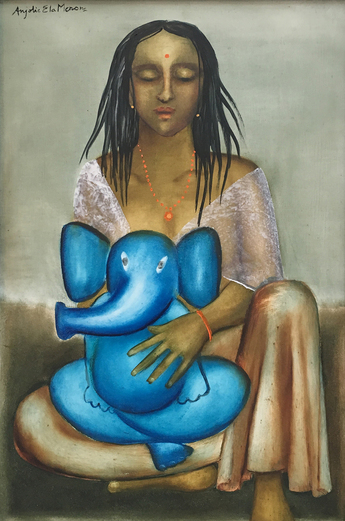-
From Current Issue
-
- Editor’s Letter Fire in the Heart
- Reviews I Gusti Ayu Kadek Murniasih
- Reviews 11th Seoul Mediacity Biennale: “One Escape at a Time”
- Dispatch Networked China
- One on One Monira Al Qadiri on Yukio Mishima
- Essays The rise of independent art spaces in pandemic-era Shanghai
- Features Tuan Andrew Nguyen
- Table of Contents
- Web Exclusives
- Archive
- Subscribe

R
E
V N
E
X
T
New York’s Aicon Gallery unveiled nearly half a century of work by the prolific Indian painter Anjolie Ela Menon in her first-ever retrospective exhibition in the United States. While the New Delhi-based artist has previously exhibited stateside, “A Retrospective” featured over 40 paintings and drawings from Menon’s oeuvre, offering American audiences a rare glimpse of early pieces borrowed from private collections alongside more recent works.
Among the newer paintings, the “Divine Mothers Series” (2016–17) recreates religious iconography within a familial context: four portraits depict famous deities and their mothers. In Yashoda with Baby Krishna (2016), one of the most widely revered Hindu gods is rendered as an infant—naked in his recognizable blue skin except for a diminutive version of his peacock feather crown—sitting in the lap of his foster mother. With her hair freely flowing over her bare arms, Yashoda’s earthly appearance is a striking contrast against the otherworldliness of her child. A similar juxtaposition occurs in Parvati with Ganesh (2016), in which a simply adorned woman holds her elephant-headed youngster. In Maya with Gautama (2016), the mother in profile faces her child-Buddha. Regarding her inspiration behind the series, Menon says, “It struck me that all these mothers are worshipped for themselves and the divinity is all encompassing—the mothers nurturing their would-be-divine babies.” Exemplifying this shared divinity, halos encircle both heads in Madonna with Child(2017).
An older painting of Madonna (1973), with elongated fingers and an amorphous silhouette, reveals the influence of foundational Indian modernist painters such as MF Husain and Amrita Sher-Gil. Although references to diverse faiths reappear throughout Menon’s work, she describes her personal beliefs as being “of a far more abstract nature.” As a young artist, she studied in Paris and traveled across Europe. Her appropriation of religious aesthetics, particularly Byzantine art, is evident in the compositions of her portraits. In a new work, the artist used the artistic tradition formerly reserved for holy likenesses to deliver images of common folk. In this case, we see New Delhi farmers with their livestock painted in a saintly manner in the triptych Goatherd (2017).
Everyday individuals also populate Pastorale I and Pastorale II (both 2015), for which the artist collaborated with the late Australian photographer Robyn Beeche for the Mumbai International Airport. Maquettes of the large-scale panels hung in the entrance of the gallery. Other experiments with media could be seen in a series of untitled paintings from 2013 that incorporate gold leaf and ornamental embellishments. Whatever the variation in medium, Menon’s dedication to figurative portraiture holds steadfast. We see over time how the artist returns to favorite subjects, like the bare-chested Namboodiri priests from the temples of South India or the mischievous crow. “The recurring figures often resemble my family, my friends and my bearded husband,” the artist explained.
Likewise, the female nude remains a fixture of Menon’s work, from the rudimentary sketches in her acrylic drawings to the abstractly positioned bodies in Falling Girl (2015). In Eden (2005) and Nude (2016), which were completed over a decade apart, the artist reuses nearly identical poses. The former presents an unmistakable Eve, complete with bitten apple and serpent in the foreground, and zebras roaming a primitive landscape further afield. The latter offers a contemporary setting—“Eve” sunbathes on a beach; a green-eyed ginger cat replaces the snake; instead of wild beasts, we see sailboats in the water, a kite in the sky, and waterside houses on the horizon.
The frequently revisited female form serves as a reminder that women have been paramount in shaping our collective cultural and spiritual identities. Often painted with their eyes closed or gazing downward, the figures convey a feeling of serenity. The mood sometimes slips into the melancholic, as the eyes of Menon’s figures are heavily darkened, suggesting a moment of reminiscence or reflection. By engaging with her subjects in such an intimate manner, Menon exalts their positions—whether heavenly or earthbound—but ultimately draws attention to their shared humanity.
Anjolie Ela Menon’s “A Retrospective” is on view at Aicon Gallery, New York, until June 24, 2017.
To read more of ArtAsiaPacific’s articles, visit our Digital Library.







